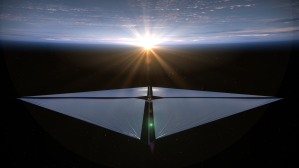A NASA airborne science mission conducting research flights over the Atlantic Ocean held an outreach event June 9 during a three-week deployment to Bermuda.
A NASA airborne science mission conducting research flights over the Atlantic Ocean held an outreach event June 9 during a three-week deployment to Bermuda.
The Aerosol Cloud meTeorology Interactions oVer the western ATlantic Experiment (ACTIVATE) is in its third and final year of flights measuring interactions between tiny atmospheric particles called aerosols, clouds and meteorology. ACTIVATE is providing much needed data on the development and evolution of low lying marine clouds — an area of climate science in which there is still significant uncertainty.
During the outreach event, the ACTIVATE team hosted more than 50 guests in a hangar at L.F. Wade International Airport in St. George’s Parish. Attendees included students from three local schools, as well as U.S. Consul General to Bermuda Karen Grissette, researchers from the Bermuda Institute of Ocean Sciences, and members of the Bermuda Civil Aviation Authority.
ACTIVATE team members gave tours of the King Air and HU-25 Falcon research aircraft, and talked to the guests about the science instrumentation and science goals of the mission.
“The fact that these NASA aircraft came in with a bunch of scientists really created a unique opportunity for us to engage with these students,” said Armin Sorooshian, ACTIVATE principal investigator and atmospheric scientist at the University of Arizona. “It gave us an opportunity to get them inspired and hooked onto airborne science — or just Earth science in general. We got lots of good feedback during the event and some students even expressed interest in coming back to the hangar to shadow us.”
The majority of ACTIVATE’s flights have been out of NASA’s Langley Research Center in Hampton, Virginia. The Bermuda deployment allowed researchers to fly farther out over the Atlantic Ocean and take measurements that were less affected by emissions from East Coast cities and differences in sea surface temperatures caused by the Gulf Stream.
Following this final flight campaign — the second of 2022 and sixth since 2020 — ACTIVATE will move into the next phase of its mission, which is to process and publicly archive data collected this year. According to Sorooshian, ACTIVATE is keen to engage the international science community so it can take advantage of a valuable dataset that took three years to collect across multiple seasons.
“The team aims to hold various types of open data workshops to educate the public community about ACTIVATE flight data,” said Sorooshian. “We’re also eager to accelerate our data analysis efforts in conjunction with modeling to advance knowledge of aerosol-cloud interactions and assess and improve remote sensing capabilities for aerosols and clouds.”
Joe Atkinson
NASA Langley Research Center
































